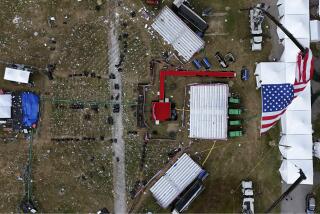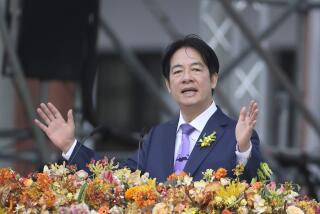China’s troop-cut plan is more about modernization than peace, analysts say
Reporting from Beijing — President Xi Jinping’s announcement Thursday that China will cut its military by 300,000 troops was couched in the language of peace. Yet analysts say that it was intended as a move to modernize and strengthen, not diminish, the country’s armed forces.
“War is the sword of Damocles that still hangs over mankind,” Xi said in a speech at Tiananmen Square commemorating the 70th anniversary of the end of World War II in the Pacific. “We must learn the lessons of history and dedicate ourselves to peace.”
Rory Medcalf, head of the National Security College at Australian National University, said however that Beijing may have planned the troop cut “in the name of efficiency and cost saving so that the defense budget can be reallocated to 21st century capabilities.”
“Infantry are no longer a measure of power,” he said. “One metric to watch is overall military spending, which goes up in China by double digits each year — ahead of economic growth. Another metric to watch is the development of new and leading-edge technologies like cyber, hypersonic missiles and submarines.”
Xi’s announcement came near the start of the highly choreographed ceremonies in central Beijing, which included a military parade showing off a slew of new armaments.
Hours after the speech, Defense Ministry spokesman Yang Yujun said that Beijing would complete the troop cuts by 2017 “in its latest effort to build slimmer but stronger armed forces,” according to the official New China News Agency. He added that the cuts would target “outdated armaments, administrative staff and noncombatant personnel.”
China has 2.3 million troops, compared with the 1.3 million members of the U.S. armed forces.
Xu Guangyu, a retired Chinese military officer and a consultant to the China Arms Control and Disarmament Assn, said that Beijing has been attempting to rebalance its forces as it puts a new emphasis on air and sea operations.
“The air force and navy have both made big gains in the last few years. But the balance of forces is still 70% army, 15% navy and 15% air force,” he said, speaking before the troop cuts were announced. “My guess is that the PLA [the People’s Liberation Army] will try to adjust that to about 50% army, 25% navy and 25% air force in the coming years.”
Pentagon officials warn that China’s rapid military modernization is aimed at projecting power in East Asia and at raising the risks the U.S. faces if it intervenes in maritime hot spots, such as the South China Sea or the Taiwan Strait, where Beijing has long-standing territorial claims.
For that reason, they say, China has spent heavily on anti-ship cruise missiles, air defense systems, submarines and other advanced weapons in hopes of forcing U.S. aircraft carriers and fighters to operate farther away from the Asian mainland if a conflict broke out.
China’s anti-ship cruise missiles based along its coastline have ranges exceeding 1,000 miles, providing “the capability to attack aircraft carriers in the Western Pacific,” said an annual Pentagon report on China’s military released in May.
China has also worked on developing ballistic missiles capable of knocking out satellites and waging cyberwars, so that if a conflict erupts, it could seek to deny the U.S. one of its chief advantages: its use of networked sensors, surveillance satellites and data transmission to find and target adversaries.
“China is investing in capabilities designed to defeat adversary power projection and counter third-party, including U.S., interventions during a crisis or conflict,” according to the report.
Timothy Heath, a senior international defense research analyst at the Rand Corp., called Xi’s announcement of the troop cut a “jarring moment” during Thursday’s event at Tiananmen Square.
“If Xi’s speech emphasized the idea that China is not a threat, that the PLA is committed to peaceful development and will ‘never seek hegemony or expansion,’ why did Xi feel compelled to announce a reduction in force?” he said. “It seemed out of place, especially when one considers that Xi omitted the fact that the troop reduction is part of a broader reorganization and reforms designed to improve the combat effectiveness of PLA forces.”
Beyond the troop announcement, defense analysts were primarily focused on the estimated 500 pieces of military hardware on display, especially two types of ballistic missiles — the Dongfeng 21D and Dongfeng 26 — that some say could change the balance of power in the region.
“Perhaps the most serious surprise was the revelation by the parade announcer that the DF-26 intermediate-range ballistic missile already is equipped with an anti-ship warhead,” said Richard Fisher, a senior fellow at the Virginia-based International Assessment and Strategy Center. He added that the missiles could potentially reach the island of Guam, where the U.S. maintains a military base.
“The DF-21D and DF-26 anti-ship ballistic missiles … demonstrate that the PLA is making progress in being able to overwhelm U.S. Navy ships with coordinated missile strikes,” Fisher added. “The most powerful U.S. response to these developments would be for the U.S. to accelerate its development of energy weapons like railguns and lasers, which hold the potential to defeat swarms of attacking missiles.”
The U.S. Navy has been developing a railgun, which can fire projectiles at seven times the speed of sound, since the 1980s. It has already positioned a laser system onboard a naval vessel in the Arabian Gulf.
Experts say that China’s military tends to play up its new capabilities — showing off test flights of still-experimental advanced stealth fighters or its lone aircraft carrier, a refurbished Ukrainian vessel called the Liaoning — to demonstrate that it can now go toe-to-toe against the American military, whose presence near its shores has long irked Beijing.
China’s leaders nonetheless have showed little interested in provoking a military conflict with Japan or other countries in the region, which could draw them into a direct face-off with the U.S. military.
“We need to keep in perspective what Chinese actions mean, and what they don’t mean,” said Jeffrey Bader, a fellow at the Brookings Institution who oversaw China relations in the Obama White House. “It has no overseas bases. It has little modern experience in combat, and deeply ingrained reluctance to intervene in foreign disputes.”
China’s military remains well behind the U.S. in many areas and beset by other problems, including corruption, that raise doubts about its ability to conduct a full-scale conventional conflict, Pentagon officials and analysts say.
Many of the theatrics during Wednesday’s parade harked back to an earlier time. Xi conducted a “troop inspection” after his speech, riding down Changan Avenue in a Chinese-manufactured Hongqi parade car — a black, retro-looking four-door sedan with a big grill and round headlights — with his upper body emerging from a hole in the roof.
“Hello comrades!” he said into four microphones affixed to the top of the car. “Comrades, you’re working hard!”
“Serve the people!” lines of camouflage-clad soldiers shouted in reply.
The parade concluded with a cloud of white doves and colorful balloons — 70,000 of each, according to the New China News Agency — released over Tiananmen Square.
Times staff writers Kaiman and Makinen reported from Beijing and Cloud from Washington. Tommy Yang and Nicole Liu in The Times’ Beijing bureau contributed to this report.
Twitter: @JRKaiman
@JulieMakLAT
@DavidCloudLAT
ALSO:
French investigators certain that debris came from Malaysia Airlines Flight 370
Guatemala President Otto Perez resigns in face of arrest warrant
U.S. response to refugee crisis is nowhere near that of Europe
More to Read
Sign up for Essential California
The most important California stories and recommendations in your inbox every morning.
You may occasionally receive promotional content from the Los Angeles Times.












